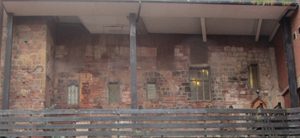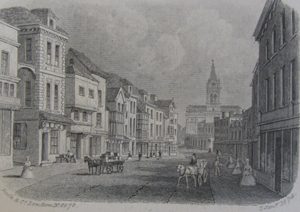
Shrewsbury’s Pride Hill needs no introduction – the street has been there since medieval times, but it has not always had that name. The neighbourhood was called Altus Vicus (High Town), and Pride Hill started as an informal name first recorded in 1378, reflecting the fact that the Pride family lived in the area. The top of the street was originally named High Pavement. Further down, on the south east side were shoemakers’ shops, hence it was called Corvisor’s Row (those who made items in leather, especially shoes, were called ‘Corvisors’). On the northwest side of the road were generous plots, which each contained a grand building, or hall. These were built chiefly between the mid-13th and 14th centuries. The halls were mostly parallel to the street, but separated from it by a courtyard. The backs of these buildings were against, or even on top of, the town wall. (Some of these features are preserved downstairs at McDonalds, and the rear can be viewed from Raven Meadows.) The plots were mostly fronted by shops, the most significant of which were butchers located opposite what we now know as Butcher Row. [footnote 1]
The Pride family lived in one, or probably more than one, of these large plots (or burgages), since we know that in 1279 the Pride family had no less than 47 such burgage plots in the town. Roger Pride alone owned 25. [footnote 2] The Prides were merchants, especially in the wool trade. At this period Shrewsbury was the most important trading centre along the River Severn, its cheap export commodity being Welsh wool destined for Flanders. [footnote 3]

For well over two centuries, the Prides were also active in civic life. Shrewsbury was largely self-governing. Its government was led by two bailiffs, elected annually, and at different times members of the Pride family were bailiffs. [footnote 4] The bailiffs were responsible for law and order, the control of all the trading activity in the town, and for raising money to pay the royal tax or ‘farm’. They were assisted by the town clerk, who was also the treasurer. It is recorded that Roger Pride held this post in 1302-3, and travelled to London in January and June of that year to take the two instalments of the town farm to the exchequer. [footnote 5] Not all the Prides were so upright – in 1398 Thomas Pride, who had been bailiff in 1398-99, was accused of embezzling money released for repairs after the great fire of 1393. [footnote 6]
The Prides were also active in national politics, being appointed MPs on many occasions. Whenever the king decided that a Parliament should meet, he directed the Borough to send two men to act as MPs. These parliaments moved around the country, meeting in Shrewsbury itself in 1283 and 1397. Thomas Pride was an MP in 1402 and 1404, so no doubt was actively involved in providing for Henry IV’s forces before and after the Battle of Shrewsbury in 1403. [footnote 7]

The Prides seem to have died out by the time of the Tudors, and subsequent centuries have seen the gradual development of the streetscape of Pride Hill as we know it today. The Corvisors at the bottom of the street were displaced, mostly by butchers, from about the late 16th century. Some of these butchers became very prosperous, rebuilding their shop frontages in a grand Queen Anne or Georgian style. Some of their dated initials on the frontages can still be seen. The modernisation of the street was completed in 1862 by Shrewsbury’s first department store, Maddox & Co, which was located on the site of Corvisor’s Row, and extended round the corner to High St. [footnote 8]
Footnotes
[1] WA Champion and AT Thacker, Victoria County History of Shropshire, Vol. VI, part 1, 2014, p.78ff
[3] http://www.historyofparliamentonline.org/volume/1386-1421/constituencies/shrewsbury
[4] Dorothy Cromarty, Everyday Life in Medieval Shrewsbury, Shropshire Books, 1991, pp.71-73
